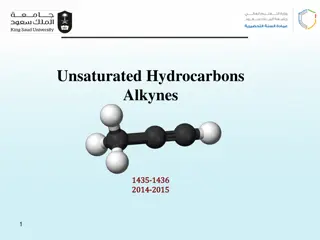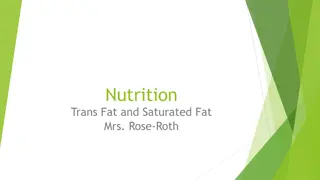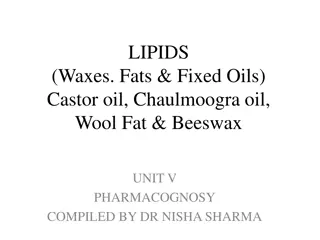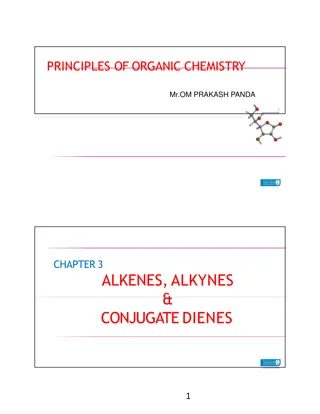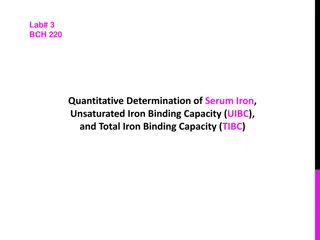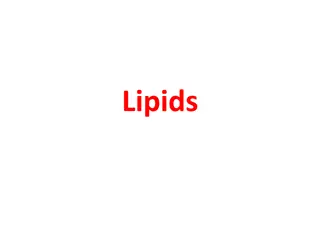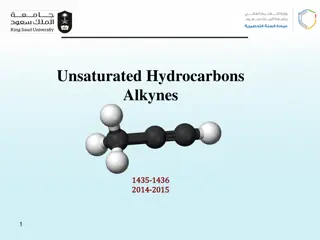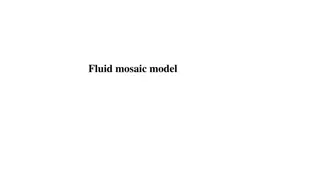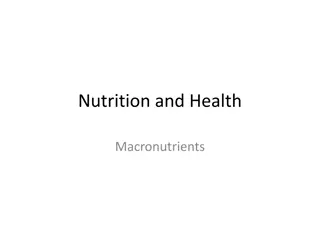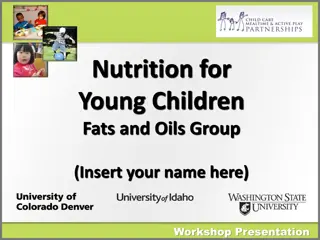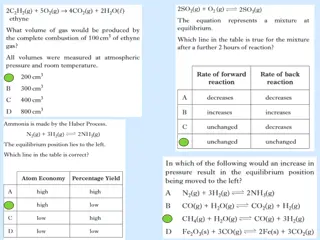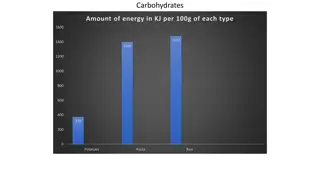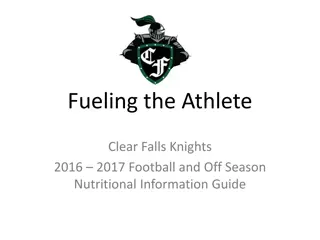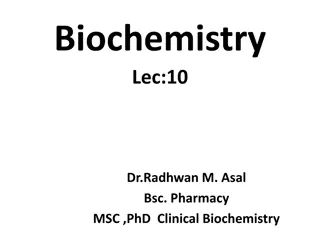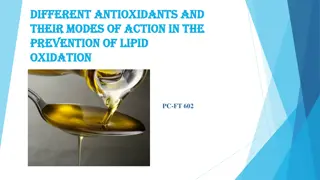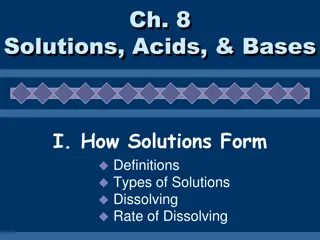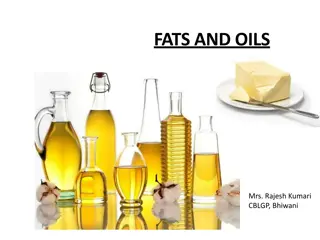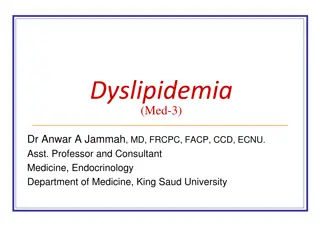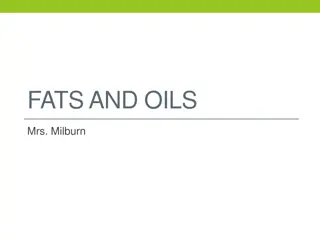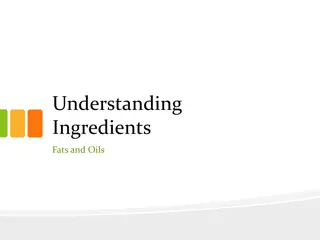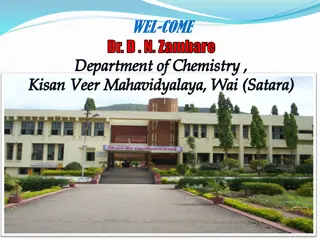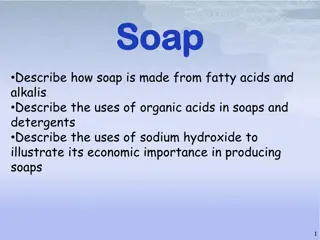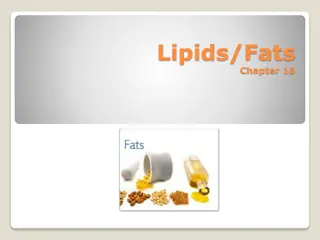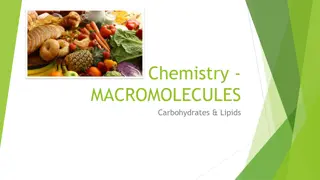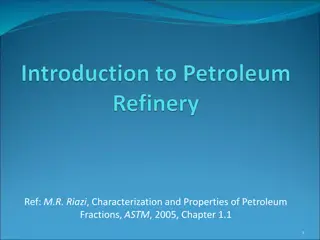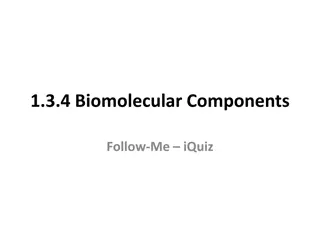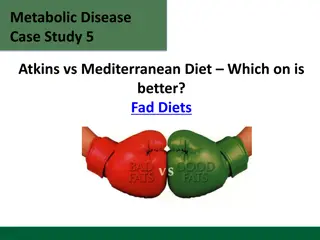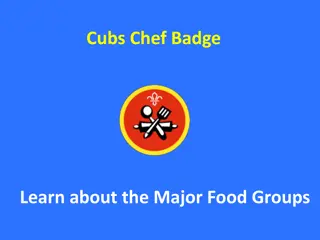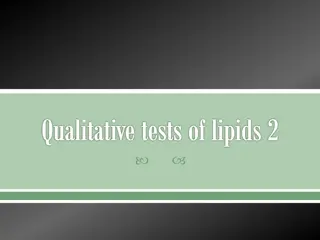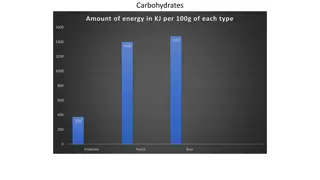Aldol Condensation Reaction: Preparation of Chalcones
Chalcones are important unsaturated aromatic ketones that serve as biogenetic precursors of flavonoids and isoflavonoids. They have various medicinal and pharmaceutical applications due to their biological activities. Chalcones are easily synthesized compounds with potential therapeutic uses, making
2 views • 13 slides
Understanding Solutions and Precipitation Reactions
Solutions are classified as saturated, unsaturated, or supersaturated based on the concentration of solute in the solvent. Solubility plays a critical role in determining the amount of solute that can be dissolved in a solvent at a given temperature. Reactions yielding products of limited solubility
6 views • 10 slides
Unsaturated Hydrocarbons Alkynes
Chapter three delves into the world of alkynes, focusing on their structure, hybridization, bonding, nomenclature, physical properties, preparation, and reactions. Alkynes are hydrocarbons with at least one triple bond, forming a homologous series with the molecular formula CnH2n-2. The sp hybridiza
0 views • 20 slides
Understanding Digestion and Absorption in the Gastrointestinal Tract
Digestion and absorption in the gastrointestinal tract are crucial processes for breaking down carbohydrates, fats, and proteins into smaller compounds that can be absorbed by the body. Carbohydrates undergo hydrolysis to convert into monosaccharides, fats are broken down from triglycerides, and pro
1 views • 22 slides
Understanding Trans Fat and Saturated Fat in Nutrition
Trans fats are unsaturated fats that can have negative health effects, found in baked goods, fried foods, and more. Saturated fats, mostly found in animal products, may increase the risk of heart disease. Learn how trans fats affect health and which foods contain them.
0 views • 11 slides
The Digestive Journey: From Skittles in the Mouth to Nutrient Absorption in the Intestine
The process begins with chewing skittles in the mouth, where salivary amylase breaks down sugar. The bolus then travels down the esophagus via peristalsis into the stomach, further broken down by gastric juice. The pancreas releases enzymes like amylase and lipase to digest sugars and fats. Bile pro
2 views • 15 slides
Understanding Lipids: Waxes, Fats, and Fixed Oils
Lipids are organic compounds like waxes, fats, and fixed oils found in plants and animals. Fixed oils are reserve food materials, while fats are solid at higher temperatures. These substances are esters of glycerol and fatty acids, with various components giving them unique properties and flavors. C
0 views • 20 slides
Understanding Alkenes, Alkynes, and Conjugate Dienes in Organic Chemistry
Alkenes and alkynes are unsaturated compounds with carbon-carbon double and triple bonds, respectively. Dienes contain two double bonds that can be cumulated, conjugated, or nonconjugated. Learn about their nomenclature and classification in this informative guide.
1 views • 33 slides
Understanding Lipids: Importance, Digestion, and Absorption
Professor Shraddha Singh's lecture series delves into the significance of lipids, the types of lipids, and the role of bile in digestion. Learn about saturated vs. unsaturated fatty acids, common fatty acids found in lipids, lipid structures, and properties. Explore the diverse types of fats we cons
2 views • 32 slides
Understanding the Hell-Volhard-Zelinsky Reaction Mechanism
The Hell-Volhard-Zelinsky (HVZ) reaction is a unique halogenation method for carboxylic acids at the alpha carbon, involving phosphorus tribromide and bromine. This mechanism, named after its chemists, requires severe conditions and can lead to specific products or limitations such as beta unsaturat
0 views • 8 slides
Aldol Condensation Reaction for Benzalacetophenone Preparation
Aldol condensation is a key reaction for preparing benzalacetophenone, also known as chalcones. Chalcones are unsaturated aromatic ketones with various medicinal applications, showcasing activities like anti-diabetic, anti-inflammatory, and anti-bacterial effects. The reaction involves combining ben
0 views • 10 slides
Understanding Serum Iron, UIBC, and TIBC in Iron Metabolism
Iron plays a crucial role in various biological processes, including oxygen transport and electron transfer. Serum iron, unsaturated iron binding capacity (UIBC), and total iron binding capacity (TIBC) tests are essential for assessing iron levels and diagnosing conditions like iron deficiency anemi
1 views • 18 slides
Understanding Lipids: Properties, Functions, and Structure
Lipids are diverse organic compounds vital for metabolism and cell functions. They are insoluble in water, serve as energy sources, aid in hormone synthesis, and form cell membranes. Fatty acids, the building blocks of lipids, provide fuel for the body. Saturated fatty acids have high melting points
0 views • 44 slides
Understanding Alkynes in Organic Chemistry
Alkynes are unsaturated hydrocarbons with at least one triple bond, following a molecular formula of CnH2n-2. This group of compounds is discussed in Chapter three, covering topics like structure, hybridization, common naming, physical properties, preparation, and reactions. The sp hybridization of
1 views • 20 slides
Understanding the Fluid Mosaic Model of Plasma Membrane Structure
The fluid mosaic model proposed by S.J. Singer and Garth L. Nicolson describes the structure of the plasma membrane as a fluid combination of phospholipids, cholesterol, proteins, and carbohydrates. This model explains how phospholipids form a stable barrier, the role of saturated and unsaturated fa
2 views • 6 slides
Aromatic Hydrocarbons: Structure, Aromaticity, and Nomenclature
Aromatic hydrocarbons, with benzene as a key example, possess unique properties due to their highly unsaturated structures. The molecular formula of benzene is C6H6, and it exhibits resonance through a planar structure with sp2-hybridized carbons. To be classified as aromatic, a compound must have a
0 views • 19 slides
Understanding Macronutrients: Carbohydrates, Sugar, Proteins, Fats
Explore the essential macronutrients including carbohydrates, sugar, proteins, and fats. Learn about their functions, types, food sources, and impact on health. Understand the role of sugar in energy provision and potential health risks. Discover the importance of starch as a common carbohydrate in
0 views • 59 slides
Understanding the Importance of Fats and Oils in Young Children's Nutrition
This workshop presentation provides trainers with detailed information on the fats and oils group, emphasizing the key nutrients, benefits to the body, recommended intake, and types of fats. It educates on the necessity of fat in children's diets, highlighting how fats contribute to overall well-bei
1 views • 17 slides
Understanding Fats and Oils: Properties and Formation
Learn about the properties of fats and oils, including their formation through a condensation reaction of glycerol with fatty acids. Explore the role of fats in the diet, different types of natural fats and oils, and the chemical composition of triglycerides. Discover the significance of fatty acids
0 views • 17 slides
Nutritional Comparison of Carbohydrates, Proteins, Fats, and Vegetables
This infographic presents the energy content in kilojoules (KJ) per 100g of different food types, including carbohydrates (potatoes, pasta, rice), proteins (shrimp, lamb, bacon), fats (olive oil, avocado, peanut butter), and vegetables (broccoli, red peppers, carrot). The data depicts the varying en
0 views • 5 slides
Essential Nutrition Guide for Athletes: Fueling the Clear Falls Knights
Understand the importance of sports nutrition for athletes, focusing on carbohydrates, protein, and fats. Learn about the best food choices to enhance performance, hydration, recovery, and body composition changes while preventing fatigue. Explore detailed information on carbohydrates, including typ
0 views • 28 slides
Understanding Lipid Biochemistry: A Comprehensive Overview
Lipids are a diverse group of compounds crucial for various biological functions. They include fats, oils, steroids, and waxes with unique properties essential for energy storage, insulation, and nerve function. Knowledge of lipid biochemistry is pivotal in understanding areas like obesity, diabetes
0 views • 38 slides
Understanding Antioxidants and Their Role in Preventing Lipid Oxidation
Lipid oxidation is a crucial chemical process affecting the quality of fats and oils, leading to off-flavors and toxicity. Antioxidants play a vital role in delaying this oxidation process by scavenging free radicals through mechanisms like free radical scavenging. They help prolong the shelf life a
0 views • 12 slides
Understanding Solutions: Definitions, Types, and Rate of Dissolving
Solutions are homogeneous mixtures of solutes dissolved in solvents. They can be saturated, unsaturated, or supersaturated based on solubility. The process of dissolving involves solvation, and factors like stirring, particle size, and temperature affect the rate of dissolving.
0 views • 53 slides
Understanding Different Types and Sources of Fats and Oils
Edible fats and oils come from three main sources - vegetable, animal, and fish. Vegetable oils are derived from plants primarily in tropical and sub-tropical regions, such as coconut palm, olive tree, groundnut or peanut plant, and soya bean. Animal fats are also a source of fats and oils. Each sou
0 views • 44 slides
Understanding Dyslipidemia and Lipid Transport in Atherosclerosis
Dyslipidemia is characterized by abnormal levels of lipids in the blood, leading to atherosclerosis. Lipid transport mechanisms play a crucial role in the formation and progression of atheromas in artery walls. Chylomicrons carry fats from the intestine to the liver, where they are processed into LD
0 views • 54 slides
Understanding Fats and Oils: Functions, Sources, and Benefits
Fats and oils play vital roles in the body, providing energy, insulation, protection, and promoting healthy skin. They are essential nutrients that offer 9 calories per gram and come from various plant and fish sources. Fat-soluble vitamins A, D, E, and K can only dissolve in fat, emphasizing the im
0 views • 30 slides
Understanding Infiltration and Unsaturated Flow in Hydrology
This content delves into the key concepts of infiltration and unsaturated flow in hydrology, focusing on calculating infiltration, cumulative infiltration, and time to ponding using the Green-Ampt method. It covers important topics such as runoff rate, infiltration capacity, cumulative infiltration,
0 views • 8 slides
Understanding Fats and Oils: Types, Structures, and Nutritional Value
Explore the types of fats and oils used in cooking, including animal fats and plant oils. Learn about the nutritive value, storage options, and cooking uses of fats and oils. Discover categories like rendered fat and hydrogenated oil, and understand their impact on health. Dive into the world of fat
0 views • 32 slides
Chemistry of Soaps and Detergents Evolution and Formation
Soaps and detergents play a vital role in human comfort, cleanliness, and industrial applications. This article delves into the chemistry involved in the formation of soaps, highlighting the compounds and processes. It explores the differences between soaps and detergents, detailing their origins an
0 views • 38 slides
Understanding Soap Making and Uses of Sodium Hydroxide
Soap, an ancient detergent made from fatty acids and alkalis like sodium hydroxide, has been utilized for over 3000 years. Fats and oils are essential raw materials for soap production, and organic acids play a role in creating esters. Sodium hydroxide, a key component in soap making, showcases its
0 views • 9 slides
Understanding Lipids and Fats in Nutrition
Lipids are essential compounds found in every living cell, categorized into triglycerides, sterols, and phospholipids. Triglycerides play a vital role in absorbing and transporting vitamins, energy storage, and cushioning organs. Understanding the difference between saturated and unsaturated fats is
0 views • 16 slides
Understanding Carbohydrates and Lipids in Macromolecules
Explore the world of carbohydrates and lipids, essential macromolecules in chemistry. Carbohydrates provide energy and are found in foods like fruits, bread, and pasta, while lipids like fats play a crucial role in storing excess energy. Discover the types of carbohydrates, digestion processes, and
0 views • 16 slides
Entomophagy and the Nutritional Benefits of Eating Grasshoppers
The International Conference on Food Technology delved into the practice of entomophagy, focusing on the consumption of grasshoppers. With over 80 edible species of grasshoppers globally, they provide essential nutrients such as proteins, fats, vitamins, and minerals. Grasshoppers are known for thei
0 views • 11 slides
Understanding Petroleum Hydrocarbons and Their Properties
Petroleum is a complex mixture of hydrocarbons, including paraffins, olefins, naphthenes, and aromatics. Paraffins are fully saturated and stable, olefins are unsaturated with double bonds, naphthenes are cyclic saturated hydrocarbons, and aromatics are cyclic unsaturated hydrocarbons containing ben
0 views • 19 slides
Understanding the Composition of Fats in Biomolecular Components
This quiz explores the differences in chemical composition between fats, highlighting factors such as fatty acids, presence of nitrogen groups, and the role of phosphate groups. It also touches on the characteristics of lipids, testing methods, and the distinction between lipids and amino acids. The
0 views • 50 slides
Comparing Atkins and Mediterranean Diets for Metabolic Disease: A Case Study
In this case study, the Atkins and Mediterranean diets are compared in terms of their impact on metabolic health. The Atkins diet focuses on low carbohydrate intake, leading to gluconeogenesis and changes in insulin levels. On the other hand, the Mediterranean diet emphasizes unsaturated fats from p
0 views • 19 slides
Learning About Food Groups with Cubs Chef Badge
Explore the major food groups with Cubs Chef Badge and the Eatwell Guide. Discover the importance of carbohydrates, fruits, vegetables, low fats, dairy, proteins, and the impact of foods high in fats, sugars, and salt on our health. Get tips on maintaining a balanced diet, preparing Rama's Best Ever
0 views • 9 slides
Qualitative Tests of Lipids and Derived Lipids Overview
Qualitative tests of lipids distinguish between oil, neutral fat, saturated fatty acids, and unsaturated fatty acids using methods like the copper acetate test. Derived lipids include substances like cholesterol and fat-soluble vitamins that are either soluble in lipids or derived from lipids throug
0 views • 14 slides
Nutritional Comparison of Carbohydrates, Proteins, Fats, and Vegetables per 100g
Explore the energy content in KJ per 100g of various food types such as potatoes, shrimp, olive oil, broccoli, and more. Compare carbohydrates, proteins, fats, and vegetables to make informed dietary choices. Visual representations included for easy understanding.
0 views • 5 slides


